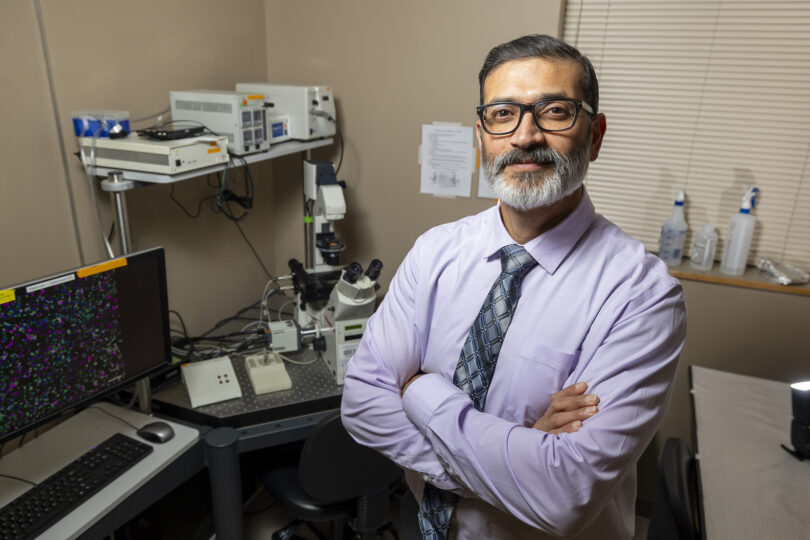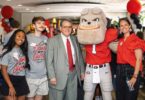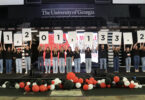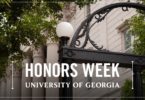Sitting in his office at the Edgar L. Rhodes Center for Animal and Dairy Science at the University of Georgia, Lohitash Karumbaiah reflects on his path from working in the agricultural biotechnology industry in India to his current role researching ways to help the brain heal itself after traumatic brain injury and disease.
“I’ve always had a deep sense of adventure and a desire for purpose, and I think my journey to where I am now reflects that quite well. Getting out of my comfort zone has been a huge part of my story,” said Karumbaiah, associate professor in the College of Agricultural and Environmental Sciences.
Driven by a pull toward the foundational science of his work, Karumbaiah made the leap from working in quality assurance and product development at Monsanto Co. (now Bayer AG) in India to his current role as the director of the Translational Glycomaterials and Neural Repair Laboratory at the Regenerative Bioscience Center.
“Before I was sitting in an office in a big city in India, I had been traveling all over the country and seeing firsthand how innovation truly impacted people, so I was anxious to get back to that,” Karumbaiah said. “That feeling only grew stronger as I began to tire of the mundane nature of my corporate position with its swanky big city office.”
With a deep appreciation of emerging technologies and a drive to get involved, he began exploring doctoral programs in the United States.
“I was admittedly very naïve about the application process, but I chose two programs I was interested in, one of which was UGA. When I heard that one of the faculty members I had considered was moving his lab and would also soon be at UGA, it felt like a sign that this was the place to be. Before I knew it, I was here in Athens,” Karumbaiah said.
The leap from industry to academia
Transitioning from research theory to practice proved more challenging than Karumbaiah expected. He credits the excellent mentorship he received from his major professor, Michael Adang, with helping him get more comfortable incorporating “hard science” into his research practice.
After earning his doctorate in entomology from CAES in 2007, Karumbaiah was considering postdoctoral opportunities, but found the agricultural biotechnology market was saturated with talent. Casting a wide net, he began to seek ways to pivot his experiences into new and different segments of bioscience. Karumbaiah applied to a lab at the Georgia Institute of Technology, led by Ravi Bellamkonda, that focused on tissue engineering. That lab was housed in the Wallace H. Coulter Department of Biomedical Engineering at the Georgia Institute of Technology and Emory University School of Medicine where Karumbaiah spent six years learning about the brain’s composition and how engineered materials could be applied to treat maladies of the brain and spinal cord — a challenging problem in regenerative medicine.
“At this point, I really came to a fork in the road — do I take this into industry or go back into academia? In academia, there are so many opportunities to carve out your own independent vision, which was exciting to me, especially since I’d already had a taste of the corporate world and its mission,” he said. “I decided to pursue a faculty position and, although I didn’t think I’d end up back at UGA, it seemed like the Regenerative Bioscience Center had a really good thing going, and I wanted to make an impact. So, here I am.”
Pioneering brain healing with tissue engineering
Since joining the UGA faculty in 2013, Karumbaiah’s drive has led to groundbreaking work in helping the brain heal itself after TBI and diseases including brain tumors. Research in his lab has led to the development of the first-ever tissue-engineered glycomaterial, or “brain glue,” which treats TBI, and an insulin medium used in treating glioblastoma, a very aggressive brain cancer with a very low survival rate.
With first results for the brain glue published in 2017, the team discovered that the material worked as a structural support that could stimulate reparative mechanisms within the brain.
“Our comprehensive studies published in 2021 showed that it did everything we hoped and more, even repairing blood vessels in the affected areas. We’ve received a patent for the technology, and right now we’re focused on translating it to humans. This presents a new set of challenges, but we’ve got a team with deep expertise, and I’m hopeful about the progress we’re making,” he said.
The future of regenerative medicine and brain repair
In his research, Karumbaiah focuses on shaping the next generation of leaders in tissue engineering and biomedical sciences by mentoring graduate students in his lab.
“I love to challenge students. All of my students have hard projects because that’s really where the impact is in our work. I had great mentors who pushed me to have confidence in my work, and having a Ph.D. means that you have a deep expertise, so I don’t want my students to leave having fears about their abilities. It’s exciting to be a part of helping them find out what’s next,” he said.
Looking ahead, Karumbaiah envisions a promising future for regenerative biosciences, particularly in brain trauma repair.
“The days when engineered tissues can replace lost tissue and recover function are very near. Our work is coming along in leaps and bounds, and I only see it accelerating from here,” he said.
To learn more about the Regenerative Bioscience Center in CAES, visit rbc.uga.edu. More information about the Translational Glycomaterials and Neural Repair Laboratory is available at karumbaiahlab.org.






